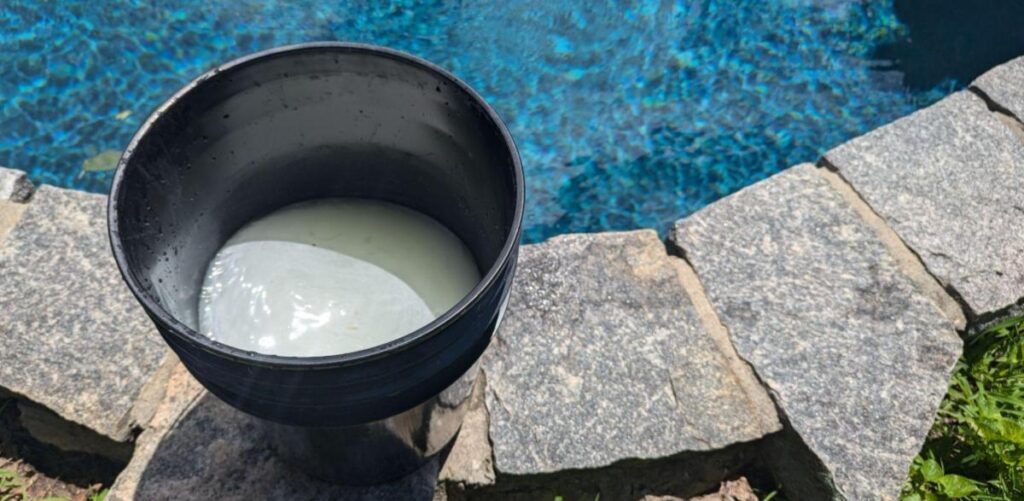Calcium hypochlorite, commonly known as cal hypo, is a powerful form of chlorine that effectively sanitizes your pool water.
However, it doesn’t just affect chlorine levels, so some sort of precautions should be used when using it as an every day sanitizer.
What is Cal Hypo?
Calcium hypochlorite is a chemical compound primarily composed of calcium, oxygen, and chlorine. It can come in slow-release tablet form or fast-dissolving granules.
Cal hypo in its granular form is widely used in the swimming pool industry as a pool shock and is often called cal hypo shock. Some stores might even just sell it as “shock”
It is an unstabilized type of chlorine, meaning it does not contain a stabilizer like cyanuric acid (CYA) in its makeup.
Because of this, using cal hypo requires manual additions of CYA to keep it balanced. Otherwise, it will burn off faster from the sun’s UV rays.
Its strengths range from 45% to 78% active chlorine, depending on which kind is used.
Since it is made with calcium, calcium hardness (CH) levels will increase. If you live in an area with hard water or have trouble maintaining calcium levels, cal hypo may not be the right choice for everyday use.
Cal Hypo As a Sanitizer
Using cal hypo is relatively straightforward, but some steps must be taken to avoid damaging or staining the pool’s surface.
- Test the water and measure how much cal hypo is needed using our pool chlorine calculator.
- Fill a five-gallon bucket with 3/4 of pool water.
- Add the amount of cal hypo to the bucket and mix thoroughly until all granules are dissolved.
- Slowly pour the mixture in front of a return jet, preferably in the deep end.
- Immediately brush any cal hypo granules that haven’t dissolved. Leaving any on the floor or surface can damage or stain the pool.

Beware of Some Safety Precautions
Cal hypo can be very dangerous if not used or stored properly. While it isn’t flammable, it can emit chlorine vapors in the air, acting as an oxidizer. This can ignite wood, oil, and other nearby materials.
It is very important to use as specified in its instructions. In granular form, use the entire package and do not leave any partially used packages lying around.
Lastly, it should never be mixed with other chemicals, including trichlor. Mixing can emit toxic fumes and even cause explosions.
If you choose to use cal hypo as pucks in a floating dispenser, thoroughly wash and clean it if it was previously used for trichlor tablets.
Should Cal Hypo Be Your Everyday Chlorine Choice?
Cal hypo’s fast-acting nature makes it one of the more popular forms of chlorination, especially as a shock treatment.
However, it is important to also know some of its drawbacks and see if it is still the right choice.
Advantages of Cal Hypo:
- Cal hypo being unstabilized means it will not add cyanuric acid to the pool. This makes maintaining CYA levels much easier
- It comes in a stronger strength compared to other unstabilized chlorine. For example, liquid chlorine is only 10-12% and lithium hypochlorite is 35% strength.
- Cal hypo will rarely degrade over time. It can be used a few years later and still maintain the same strength as when it was newly packaged.
- It is versatile enough to be used as a daily chlorinator or as a shock treatment to address sudden water issues.
Disadvantages of Cal Hypo:
- Calcium hypochlorite is typically more expensive than other chlorines. While it may come in higher strengths, the price could make it more costly per season.
- Since it contains calcium, it will increase calcium hardness. Over time, high calcium can cause severe damage to pool equipment and plumbing if it isn’t properly maintained.
Should I Continue to Use Cal Hypo?
The decision to continue using cal hypo ultimately depends on your pool’s specific needs and your water preferences.
The main drawback is the addition of calcium. Hard water areas should not necessarily be using cal hypo on a daily basis and should consider liquid chlorine as a shocking treatment.
As always, remember to regularly test your pool water, check those calcium levels, and have fun enjoying the pool!

